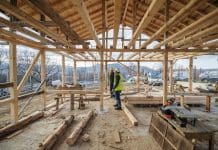Rural communities face an urban exodus if a sustainable solution to the countryside’s housing crisis is not found. It is time for bungalows to be recognised as part of this solution says Henry Robinson, President at the CLA…
Since the 1940s, house building in the countryside has stalled. For decades, retirees looking to downsize have been left with nowhere to go. With no suitable alternative housing available to them, and reluctant to lose their support networks by moving into towns and cities, many older people have felt they have no option but to remain in costlyto- run family houses. Not only has this removed much-needed family housing from the market, it has debilitated rural services, limited rural employment and prevented rural employees living close to their place of work.
With Britain’s aging population expected to account for 54% of households aged over 65 by 2021 and in rural areas, the number of over-65s rising 2.5 times faster than in towns and cities, this situation can ultimately only lead to the death of rural villages.
In the CLA’s housing policy document ‘Tackling the housing crisis in England’ we clearly identify the need to enable elderly owner occupiers, retired rural employees and tenant farmers, to downsize as a key restructuring requirement within villages and offer up bungalows as part of the solution. A solution since echoed by Housing Minister Brandon Lewis.
Bungalows provide a smaller, easy to maintain and more manageable living space for older generations who do not feel ready to move into retirement housing. They allow older occupants to remain in the area they know and have contributed to, simultaneously freeing up larger, vitally needed family housing.
For decades, landowners have been frustrated with the severe and entrenched limits put on bringing forward land for any kind of rural development.
Where small housing units existed, it has paid to extend them as much as possible to cash in on the plot value removing them from the retirement market. Local authorities must look at issuing planning restrictions preventing them from being extended upwards or outwards meaning that they remain available for older people. The development of the new National Planning Practice Framework (NPPF) and National Planning Policy Guidance (NPPG) has been an arduous journey, but the results are finally beginning to deliver change. It is my view that the positive planning changes should be used to deliver new bungalows in rural villages.
There is still some stigma surrounding bungalows but this can be addressed with good design. The NPPG states that local plan allocations are relevant to all types of settlements and focuses in part on older persons housing, and with the re-launch of Building for Life 12, some of the well-deserved criticism of bungalows on aesthetic grounds can be put to be bed. This is because alongside the design policies of the LPA, the ubiquitous kit-built, pebble dashed, shallow-roofed bungalows of the past, should be easier to refuse.
The beauty of bungalow developments is that although they require bigger plots than two story homes, they are low-impact on the skyline in instances where the site is highly visible topographically. This is why we have identified deep pitched roofed properties of traditional appearance as appropriate in rural locations.
Don’t forget, less than 10 percent of the UK land mass is covered by development activity – much less than many people believe to be the case. Despite the fact they are more land hungry, in view of our aging population time bomb, bungalows have a role to play in all settlements – not just rural.
Henry Robinson
President
CLA (Country Land and Business Association)
















